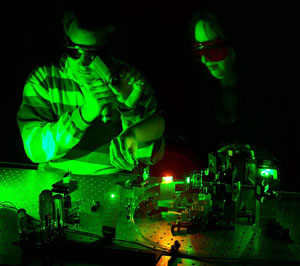
Students Steve Jensen and Catherine De Marco
working on the 20fs Ti:Sapphire laser.
Research:
My research is in the area of ultrafast laser physics. Here's a picture of my students working on our Ti:Sapphire utlrafast laser.

Students Steve Jensen and Catherine De Marco
working on the 20fs Ti:Sapphire laser.
Two projects are under way:
Steve Jensen is working on a new version of a pulse measurement tool called SPIDER (Spectral Phase Interferometry for Direct Electric-field Reconstruction). This is a technique that is capable of measuring both the amplitude and phase of ultrashort laser pulses. You can contact Steve at <stevenheather@nctimes.net>.
Catherine DeMarco is working on a project called BAGLE (Beam Alignment
Guide for Laser Experiments). It will be used to analyze and lock
the beam-pointing of the ultrafast laser. Catherine's e-mail is <cdemarco@rohan.sdsu.edu>.